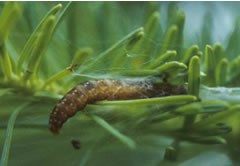Natural Resources Canada (NRCan) has sought the public's help in a continuing effort to understand the migratory patterns of an insect that will cause devastating damage to forests locally, provincially and beyond.
Spruce budworm is native to North America and is the most destructive pest of spruce and fir forests on the continent. They are an especially wasteful species, as the larvae only eat part of the needle, and then move on to other needles. Spruce budworm prefers balsam fir but gets its association to white spruce because it is a more desirable tree to loggers.
"Severely affected stands turn a rust colour as a result of dried-out needles held by strands of silk spun by the larvae. In the fall, most dead needles fall off. Defoliated stands take on a greyish appearance.
"A single year of defoliation weakens the tree, making it more susceptible to attack by other insects. Defoliation over a few consecutive years causes tree growth loss. If severe defoliation continues uninterrupted over several years, many trees will die, while others will continue to decline for several years, even after the end of the infestation. Fir trees will die after four to five consecutive years of severe defoliation," according to NRCan.
These dead trees then act as tinder to fuel forest fires.
For more on spruce budworm identification and life cycle click here.
According to NRCan, three outbreaks have occurred in eastern North America since 1900. The last was found in eastern Canada between 1966 and 1992, affecting over 50 million hectares.
A new outbreak of about 3000 hectares was detected in Quebec, on the north shore of the St. Lawrence River. The affected area has doubled in size each year since it was discovered in 2006. As of 2013, over 3.2 million hectares of forest in Quebec had suffered moderate to severe defoliation.
Dr. Christian MacQuarrie is a Research Scientist in the Pest Management Division at Natural Resources Canada. He graciously took time off from his busy research schedule to explain highly scientific data in layman's terms.
Dr. MacQuarrie first pointed out that without the citizen researchers, the program was dead in its tracks. "They help us in two ways. First, they allow us to trap the insect in places we normally cannot access (private properties). Secondly, they allow us to understand better when the insect is flying."
The province of Ontario (and other affected provinces) monitor for budworm yearly, using a network of insect traps that are set in June and collected in August. The citizen tracking program expands the typical network, producing results from a much larger area in a cost-friendly way.
The public trackers check their traps more frequently than the province does, sometimes as many as three times weekly, as opposed to once per season by the province.
"This gives us data that we can use to understand when and where the insect is flying. One of our long-term goals is to take the data and use it to build models that better predict when the insect is moving around the landscape," explained MacQuarrie.
MacQuarrie also points out that lab experience or even a scientific background are not necessary to take part in the study. The citizen trackers put the moths in a bag and record their finding in a notebook, and enter their data on a website. "At the end of the summer, they return all of the moths they've caught to the tracker program. We check the sample to confirm that the moths caught were indeed budworm, and then use the moths for other experiments," clarified MacQuarrie.
When asked if the spread of spruce budworm alarms him as a scientist, MacQuarrie responded, "I'm not sure 'alarm' is the correct word. Spruce budworm is native to the boreal forest and has an important role (food for birds), and the outbreaks that we're observing are a normal occurrence.
"We are interested in studying spread because it's one important piece of the budworm puzzle that's been very hard to figure out," even though studies have been conducted for decades, said MacQuarrie. "What's unique about this outbreak is that we have tools that we didn't have during the last outbreak that, hopefully, will let us crack this particular nut."
The largest outbreaks are found in northern Quebec, but will eventually spread to the Nipissing region, making the research a priority for scientists in Ontario. There has already been defoliation in the Temagami-Latchford area, with indications that it has spread north and east from there. There has also been damage found on St. Joseph Island near Sault Ste. Marie.
MacQuarrie cautions that spruce budworm is always found in the boreal forest. An outbreak is kept in check by environmental factors such as disease, other insects and predators (like birds).
The deforestation issue arises when populations escape these natural controls and flourish. Larger than normal numbers of moths then disperse and cause outbreaks in other areas. This is what the budworm tracking program is helping scientists to understand. The better the comprehension and ability to predict future outbreaks, the earlier scientists can warn landowners or the province, giving more time to decide on how to manage and outbreak.
Asked if the spruce budworm defoliation could be compared to North Bay's tent caterpillar infestations, Dr. MacQuarrie indicated that the major difference between the two were time frames. "Tent caterpillar outbreaks tend to be shorter (1-3 years) and more frequent (every 10-20 years) and the insect doesn't typically kill trees. Spruce budworm outbreaks are longer, and occur less frequently (every 35 years or so), and typically kill trees. They also feed on different trees too, tent caterpillars feed on broad-leaved trees (birch, aspen, maple) and budworm on conifers (spruce and fir)," responded MacQuarrie.



